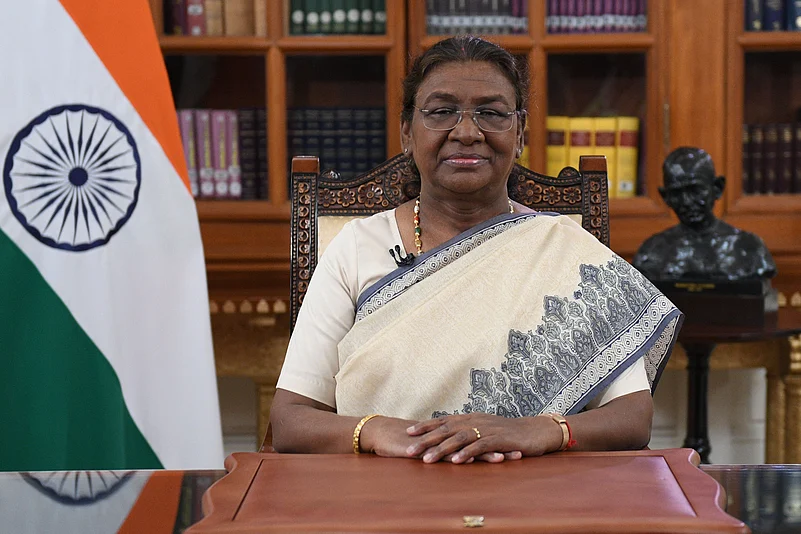President Droupadi Murmu on Tuesday (December 10, 2024) while speaking at an event hosted by the National Human Rights Commission (NHRC) in New Delhi said cyber crimes and climate change have emerged as "new threats to human rights".
Speaking on the occasion of Human Rights Day, observed on December 10 each year to commemorate the Universal Declaration of Human Rights (UDHR) adopted and proclaimed by the United Nations General Assembly in 1948, President Murmu said that climate change forces us to review the human rights situation at a global level.
"As we progress into the future, we are confronted with emerging challenges. Cyber crimes and climate change are new threats to human rights," Murmu said.
Human rights discourse is centered around "human agency" as the violator is assumed to be a human being who has a "range of human emotions such as compassion and guilt", Murmu said. However, with artificial intelligence (AI) entering our lives, the culprit could be "a non-human but intelligent agent", she added.
Murmu also said that while being transformative, the digital era had brought with it complex issues such as cyber bullying, deepfake, privacy concerns and spread of misinformation.
"These challenges underscore the importance of fostering a safe, secure and equitable digital environment that protect the rights and dignity of every individual," the President said.
Talking about AI, she mentioned, "AI has now entered our day-to-day life, solving many problems, and creating several new ones too."
Protection from Climate Change a Right
In April 2021, the Supreme Court of India, delivered a landmark judgement recognising the right to be free against the adverse effects of climate change as a fundamental right, to be included under Article 14 and Article 21 of the Indian Constitution.
2024 has been the hottest year till now and the world is set to witness 3 degrees Celsius warming by the end of the century compared to pre-industrial levels in 1990. Heatwaves, uneven rainfalls, floods and cyclones have been the highlights of the year in India, in addition to record air quality index levels in the capital city.
According to a recent report by the Centre for Science and Environment (CSE) and Down To Earth, India experienced extreme weather events on 255 out of 274 days in the first nine months of 2024, increasing from 235 days in 2023 and 241 days in 2022.
The study—that analysed occurrence of seven extreme weather events including lightning and storms, heavy rains, floods and landslides, heatwaves, coldwaves and cold days, cloudbursts, cyclones and snowfall—suggested that 3,228 people lost their lives in 2024 due to such events. The tally was 2,755 in 2022.
Considering the rising threats of climate change and its related effects, the 2021 judgement by the Supreme Court was delivered amid a growing consensus among nations regarding the impacts of climate change. During the verdict, the apex court noted that that the consequences of climate change are an infringement of the fundamental rights to life and personal liberty enshrined in the Constitution.
The Landmark Case that Led to a Landmark Verdict
The Supreme Court's judgement, dated 29 April 2021, was regarding the protection of two indigenous avian species, the great Indian bustard and the lesser Florican. The petition was originally filed in 2019 by MK Ranjitsinh Jhala, former chairman of the Wildlife Trust of India, seeking urgent action to protect endangered species and their habitat.
"Pollution, climate change, predators and competition with invasive species are among the many threats that exacerbate the challenges faced by these vulnerable species," noted the bench of judges led by Former Chief Justice of India DY Chandrachud.
According to WWF, the great Indian bustard is confined mostly to Rajasthan and Gujarat in India. However, a small population can be found in Maharashtra, Karnataka and Andhra Pradesh. Bustards generally favour flat open landscapes with minimal visual obstruction and disturbance, therefore adapt well in grasslands.
The apex court also noted how expansion of human population and accompanying activities have led to the fragmentation of the great Indian bustard's habitat. "The expansion of infrastructure such as roads, mining and farming activities have cumulatively contributed to the dangers faced by the avian species," it said.
The Supreme Court also formed a committee to determine the scope and feasibility of setting up overhead and underground electric lines in priority areas, as highlighted in the reports shared by the petitioner. It also passed directions regarding the panel's role in recommending measures ensuring the long-term survival of the great Indian bustard in these priority areas, and facilitating an increase in its population.
Measures aimed at replenishing the population of the indigenous bird species could include habitat restoration, anti-poaching initiatives and community engagement programs, stated the court.





























